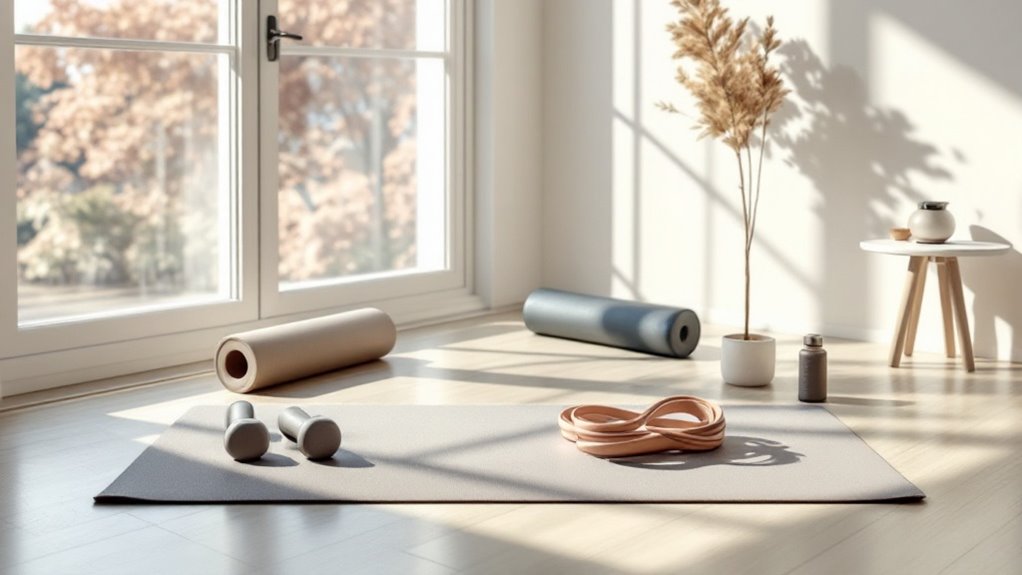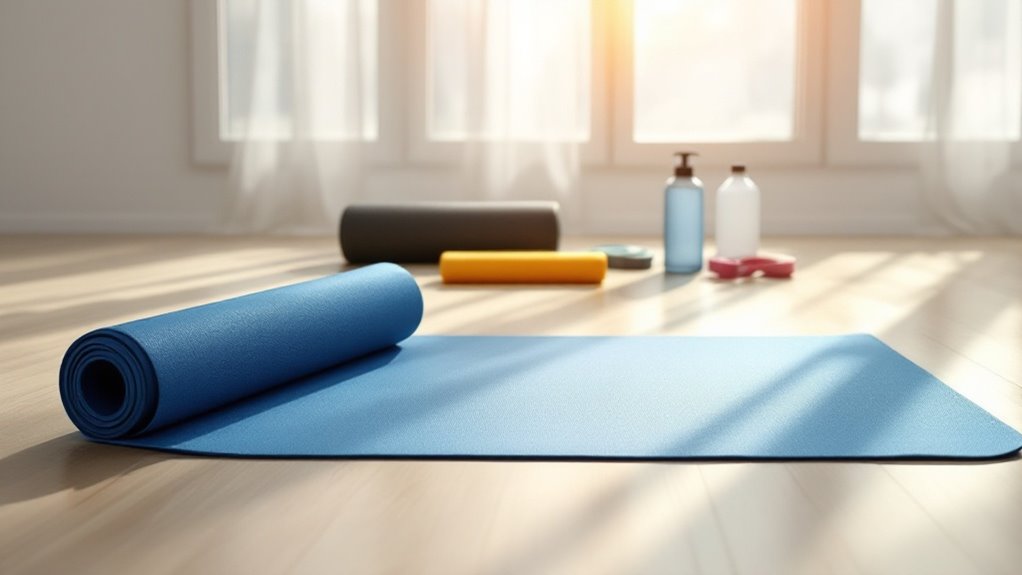How to Start Working Out

Starting a workout routine begins with mastering fundamental movements like squats, push-ups, and planks. Three 30-minute sessions per week allow proper recovery while building consistency. Beginners should focus on bodyweight exercises to develop proper form before progressing to weights. Basic equipment needs include athletic shoes, comfortable clothes, and a water bottle. Setting realistic SMART goals and tracking progress guarantees long-term success. A structured approach opens the path to sustainable fitness transformation.
Key Takeaways
- Start with three 30-minute full-body workout sessions per week, focusing on basic movements like squats, push-ups, and planks.
- Invest in essential gear including comfortable shoes, moisture-wicking clothes, and a water bottle for proper workout preparation.
- Set realistic SMART goals with measurable milestones to track progress and maintain motivation throughout your fitness journey.
- Begin with bodyweight exercises to develop proper form and minimize injury risk before progressing to more challenging workouts.
- Alternate between strength training and cardiovascular activities while maintaining a workout log to monitor improvements.
Building Your Exercise Foundation: The Basics

Starting a fitness journey requires laying down a solid foundation, much like building a house from the ground up. The basics form the cornerstone of any successful workout regimen, focusing on proper form, consistent routines, and gradual progression.
Beginners should master fundamental movements: squats, push-ups, planks, and walking. These exercises build core strength, stability, and endurance without requiring equipment. Starting with bodyweight exercises allows proper form development while minimizing injury risk.
Creating a sustainable schedule is essential. Three 30-minute sessions per week provide adequate recovery time while establishing consistency.
This approach builds momentum and creates lasting habits that serve as building blocks for advanced training. Following progressive overload techniques helps beginners safely advance their fitness level over time.
Creating a Simple Workout Plan That Works

Every successful workout plan starts with a clear blueprint that eliminates guesswork and creates structure. A well-designed routine considers individual goals, current fitness level, and available time while incorporating progressive overload principles for continuous improvement.
- Schedule three to four workout sessions per week, focusing on full-body exercises initially.
- Alternate between strength training and cardiovascular activities to build balanced fitness.
- Include essential compound movements: squats, pushups, lunges, and dumbbell rows.
- Start with manageable 30-minute sessions, gradually increasing duration and intensity as fitness improves.
Many exercises can be performed using body weight exercises at home without expensive gym equipment.
Essential Equipment and Gear for Beginners

One of the most common misconceptions about starting a fitness journey is that it requires an extensive collection of expensive equipment.
The truth is, beginners can achieve remarkable results with minimal gear. Essential items include comfortable athletic shoes, moisture-wicking clothes, and a water bottle.
Starting your fitness journey doesn't require a gym full of equipment – just quality basics and the commitment to use them.
For strength training, resistance bands and a yoga mat provide versatile options at home. As progress develops, adding dumbbells or kettle bells can improve workouts.
A fitness tracker or smartphone app helps monitor progress, while proper socks prevent blisters.
The key is investing in quality basics rather than accumulating unnecessary gear. Remember: the most important equipment is consistency and determination.
Creating a dedicated workout space in your home can help maintain motivation and make your fitness routine more convenient and sustainable.
Setting Realistic Goals and Tracking Progress
Success in fitness begins with a clear roadmap and measurable milestones. Setting realistic goals helps maintain motivation while preventing burnout and injury. The key is establishing both short-term and long-term objectives that coordinate with one's current fitness level and lifestyle commitments. Similar to proper nutrition planning, maintaining consistency requires balancing your fitness goals with lifestyle factors and social situations.
- Start with baseline measurements: weight, body composition, endurance levels, and strength metrics.
- Set SMART goals: Specific, Measurable, Achievable, Relevant, and Time-bound objectives.
- Track progress using workout logs, fitness apps, or journals to document improvements.
- Celebrate small victories and adjust goals periodically based on performance and feedback.
Frequently Asked Questions
Should I Eat Before or After My Workout, and What's Best?
Timing nutrition around workouts depends on individual goals and workout intensity.
For peak performance, eating a light meal containing carbs and protein 2-3 hours before exercise provides sustained energy.
Post-workout nutrition within 30 minutes helps muscle recovery – prioritize protein and carbs.
If working out early, a banana or protein shake works pre-workout.
The key is experimenting to find what feels best while maintaining consistent energy levels.
What Time of Day Gives the Best Results for Exercising?
Research shows the ideal workout time varies by individual goals and lifestyle.
Morning workouts boost metabolism and consistency due to fewer daily disruptions.
Afternoon sessions (2-6 PM) offer peak body temperature and muscle strength.
Evening workouts can relieve stress but may impact sleep.
The best time eventually depends on personal schedule sustainability and energy levels – consistency matters more than timing.
How Do I Avoid Muscle Soreness After Starting a New Workout Routine?
To minimize post-workout muscle soreness, one should start gradually and follow key strategies.
Dynamic stretching before exercise warms up muscles, while proper cool-down stretches afterward aid recovery. Staying hydrated, getting adequate protein, and using foam rollers can reduce discomfort.
Rest days between workouts are essential for muscle repair.
For immediate relief, gentle movement, ice packs, and compression garments prove effective.
Is It Normal to Feel Dizzy or Lightheaded During Exercise?
Studies show up to 90% of athletes experience dizziness during intense workouts at some point.
While mild lightheadedness during exercise can be normal, especially for beginners, it often signals correctable issues like dehydration, low blood sugar, or improper breathing.
Athletes should stay hydrated, eat properly before workouts, focus on steady breathing, and gradually increase intensity.
However, persistent dizziness requires medical evaluation to guarantee safety.
How Long Should I Rest Between Different Muscle Group Workouts?
Recovery between muscle group workouts typically requires 48-72 hours for ideal results.
The major muscle groups – chest, back, legs, shoulders, and arms – need this time to repair and grow stronger.
Advanced athletes might recover faster, while beginners should lean toward longer rest periods.
Smaller muscle groups, like abs and calves, can handle more frequent training.
Following a push-pull-legs split routine helps organize these rest intervals effectively.
Final Thoughts
Studies show that 67% of gym memberships go unused, but those who stick to a consistent workout routine for the first 66 days are far more likely to make it a lasting habit. Starting a fitness journey doesn't require complex equipment or elaborate plans – just commitment and proper guidance. By following fundamental principles, setting realistic goals, and maintaining consistency, anyone can transform their health through regular exercise.


